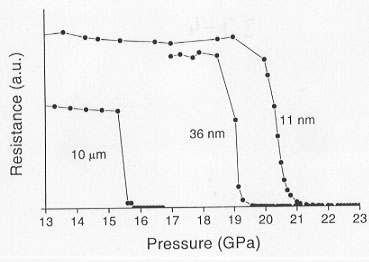

The semiconductor-to-metal transitions in a few II-VI semiconductor compounds are used to construct fixed-point static pressure calibrations for the multianvil apparatus. Nanocrystals, consisting of small crystallites of diameter 1-100 nm, often have novel physical and chemical properties, differing from those of the corresponding bulk materials. The effect of crystallite size on structural stability in these nanocrystals is of considerable interest from a fundamental viewpoint, and also with respect to the commercial applicability of these materials. The stability fields of nanocrystalline solid structures may be significantly different from the bulk materials. In this project the effect of different crystal sizes on the high pressure stability fields of various semiconductor materials is explored.
We have investigated the grain-size effect on the pressure-induced phase transition in nanocrystalline ZnS by in-situ high-pressure electrical resistance, optical microscopy, and synchrotron radiation X-ray powder diffraction measurements. In-situ high-pressure electrical resistance measurements for ZnS materials with average grain sizes of 10 µm, 36 nm, and 11 nm at ambient temperature are shown in Figure 3.7-4. The semiconductor-to-metal transition pressure strongly depends on the grain size of ZnS crystals. The smaller the grain size, the higher the transition pressure and a 1000 fold decrease in grain size shifts the transition pressure by over 5 GPa. No obvious difference in compressibility was detected in ZnS samples with various average grain sizes. The enhancement of the transition pressure in nanocrystalline ZnS might be explained by the surface energy differences between the phases, while the ratio of volume changes for bulk and nanocrystal at transitions is found to be almost the same within experimental uncertainty. Similar measurements have been performed on ZnO, PbS, and TiO2. It appears that the grain-size effect can shift transition pressures to either higher or lower pressure depending on the compound under investigation. These experimental data infer that there may be dangers in the use of II-VI compounds as pressure calibrators without a detailed knowledge of the grain size and its effect on the transition pressure for that particular compound.
 |
Fig: 3.7-4: High-pressure in-situ electrical resistance for ZnS materials with average grain sizes of 10 µ
m, 36 nm, and 11 nm at ambient temperature. |

Tel: +49-(0) 921 55 3700 / 3766, Fax: +49-(0) 921 55 3769, E-mail: bayerisches.geoinstitut(at)uni-bayreuth.de
 Previous page
Previous page